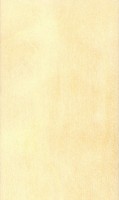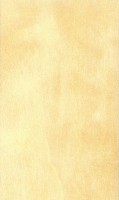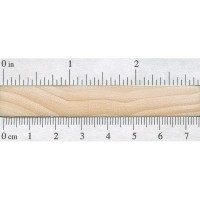 |
Common Name(s): Quaking Aspen Scientific Name: Populus tremuloides Distribution: Canada and northern United States Tree Size: 65-100 ft (20-30 m) tall, 2-3 ft (.6-1.0 m) trunk diameter Average Dried Weight: 26 lbs/ft3 (415 kg/m3) Specific Gravity (Basic, 12% MC): .35, .42 Janka Hardness: 350 lbf (1,560 N) Modulus of Rupture: 8,400 lbf/in2 (57.9 MPa) Elastic Modulus: 1,180,000 lbf/in2 (8.14 GPa) Crushing Strength: 4,250 lbf/in2 (29.3 MPa) Shrinkage: Radial: 3.5%, Tangential: 6.7%, Volumetric: 11.5%, T/R Ratio: 1.9 |
Color/Appearance: Heartwood tends to be a light brown. Wide sapwood is a pale yellow to nearly white, and isn’t clearly demarcated, tending to gradually blend into the heartwood.
Grain/Texture: Grain is generally straight, with a uniform medium texture. Low natural luster.
Endgrain: Diffuse-porous; solitary and radial multiples; medium pores in no specific arrangement, moderately numerous to numerous; parenchyma marginal; narrow rays, spacing fairly close.
Rot Resistance: Rated as non-durable, and also susceptible to insect attack.
Workability: Easy to work with hand and machine tools, though sharp cutters are necessary when planing to avoid fuzzy surfaces, (subsequent fine-sanding may be necessary to obtain a smooth surface). Does not split easily, and has poor nail-holding capability. Wood has a tendency to warp and distort during drying. Glues and finishes well.
Odor: No characteristic odor.
Allergies/Toxicity: Besides the standard health risks associated with any type of wood dust, no further health reactions have been associated with Quaking Aspen. See the articles Wood Allergies and Toxicity and Wood Dust Safety for more information.
Pricing/Availability: Aspen is commonly harvested as lumber, and is used for pulpwood in paper manufacture. Wide planks of Aspen lumber should be available within its natural range for a modest price.
Sustainability: This wood species is not listed in the CITES Appendices or on the IUCN Red List of Threatened Species.
Common Uses: Boxes/crates, veneer, plywood, and various utility purposes.
Comments: So named because the tree’s leaves tremble and quake even in a light breeze. This is caused by the long, flatted stalks (called petioles) on which the leaves are attached to the branches.
Quaking Aspen was made the state tree of Utah in 2014; it replaced the Colorado Blue Spruce, which had been its state tree since 1933.








On: “common uses” it could maybe be an interesting fact for some, that aspen often is used as wall panels in Saunas. That goes for sweden at least, but I think we Scandinavians tend to use it a lot for that.
The softness of the wood, and the fact that it doesnt have that many knots, makes it ideal for really hot rooms. It does not absorb that much heat, so you can comfortably sit on it in your birthday suit, even when the room come up to really high temperatures.